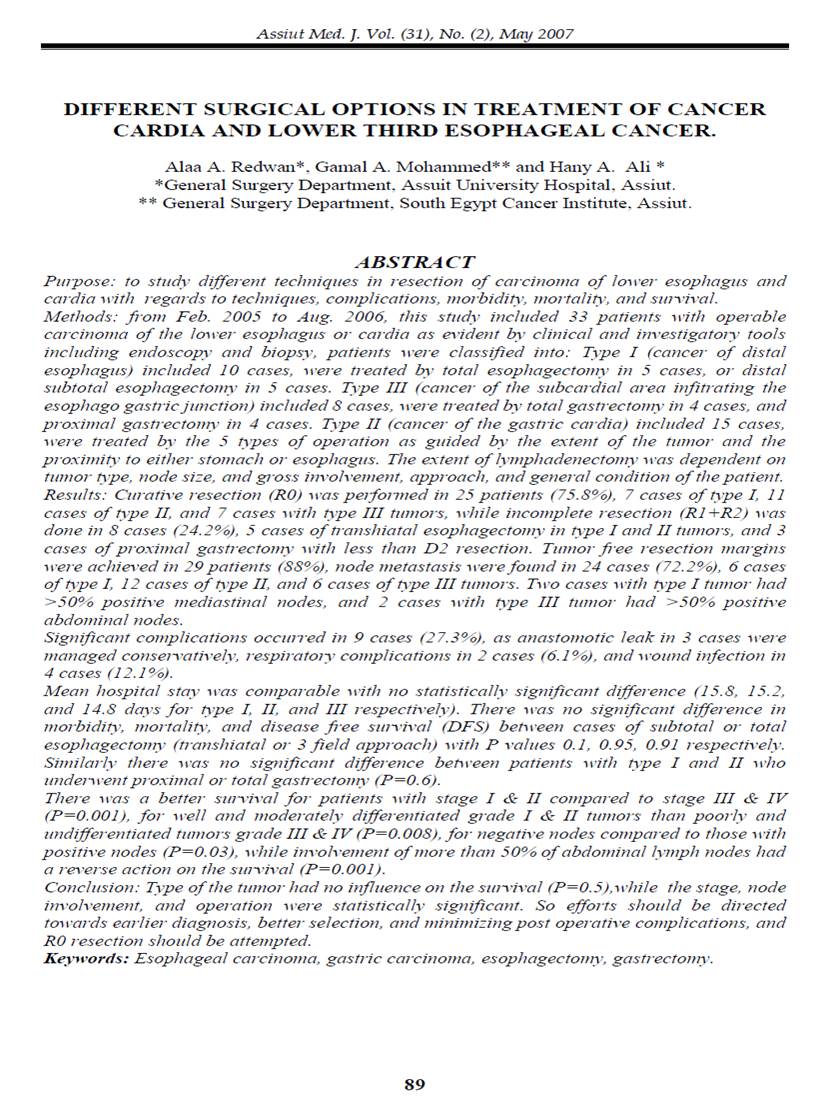ABSTRACT
Purpose: to study different techniques in resection of carcinoma of lower esophagus and cardia with regards to techniques, complications, morbidity, mortality, and survival.
Methods: from Feb. 2005 to Aug. 2006, this study included 33 patients with operable carcinoma of the lower esophagus or cardia as evident by clinical and investigatory tools including endoscopy and biopsy, patients were classified into: Type I (cancer of distal esophagus) included 10 cases, were treated by total esophagectomy in 5 cases, or distal subtotal esophagectomy in 5 cases. Type III (cancer of the subcardial area infitrating the esophago gastric junction) included 8 cases, were treated by total gastrectomy in 4 cases, and proximal gastrectomy in 4 cases. Type II (cancer of the gastric cardia) included 15 cases, were treated by the 5 types of operation as guided by the extent of the tumor and the proximity to either stomach or esophagus. The extent of lymphadenectomy was dependent on tumor type, node size, and gross involvement, approach, and general condition of the patient.
Results: Curative resection (R0) was performed in 25 patients (75.8%), 7 cases of type I, 11 cases of type II, and 7 cases with type III tumors, while incomplete resection (R1+R2) was done in 8 cases (24.2%), 5 cases of transhiatal esophagectomy in type I and II tumors, and 3 cases of proximal gastrectomy with less than D2 resection. Tumor free resection margins were achieved in 29 patients (88%), node metastasis were found in 24 cases (72.2%), 6 cases of type I, 12 cases of type II, and 6 cases of type III tumors. Two cases with type I tumor had >50% positive mediastinal nodes, and 2 cases with type III tumor had >50% positive abdominal nodes.
Significant complications occurred in 9 cases (27.3%), as anastomotic leak in 3 cases were managed conservatively, respiratory complications in 2 cases (6.1%), and wound infection in 4 cases (12.1%).
Mean hospital stay was comparable with no statistically significant difference (15.8, 15.2, and 14.8 days for type I, II, and III respectively). There was no significant difference in morbidity, mortality, and disease free survival (DFS) between cases of subtotal or total esophagectomy (transhiatal or 3 field approach) with P values 0.1, 0.95, 0.91 respectively. Similarly there was no significant difference between patients with type I and II who underwent proximal or total gastrectomy (P=0.6).
There was a better survival for patients with stage I & II compared to stage III & IV (P=0.001), for well and moderately differentiated grade I & II tumors than poorly and undifferentiated tumors grade III & IV (P=0.008), for negative nodes compared to those with positive nodes (P=0.03), while involvement of more than 50% of abdominal lymph nodes had a reverse action on the survival (P=0.001).
Conclusion: Type of the tumor had no influence on the survival (P=0.5),while the stage, node involvement, and operation were statistically significant. So efforts should be directed towards earlier diagnosis, better selection, and minimizing post operative complications, and R0 resection should be attempted.


